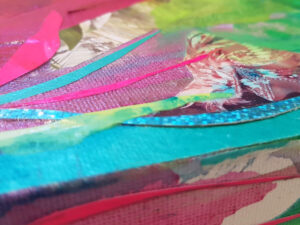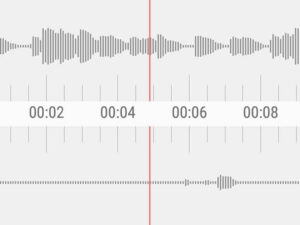
Featured Image: Close-up of Shh the Neighbours will Hear by Leigh
20 Feb 2019
I had a fabulous meeting in CSM this morning, so fabulous that I wasn’t an hour early for class as I’d normally be. I arrived at LCC, Elephant & Castle with 20 minutes to grab lunch, eat it and find my way to the 14th floor of the Tower Block. And the reason I’m describing all this to you?
In that 20 minutes, I found myself having an impromptu five minute conversation with two classmates in the cafeteria that coloured the way I viewed and absorbed today’s class.
(Commence the loose paraphrasing)
Colleague 1: What do you think of this class? I’m not feeling it at all. It’s not doing much for me.
Colleague 2: I haven’t decided yet. The thing that struck me though is what they said on the first day, “We’re not going to teach you how to teach”.
Colleague 1: Yes! That really surprised me because I mean what’s the point of the course then? How are you finding it? (turning to me)
Me: I feel like my elective has helped me make more sense of it so far. I’m starting to see everything from a critical pedagogy standpoint so it feels like it’s making sense to me. What electives are you taking?
Colleague 1: Technology something or other
Colleague 2: Academic Practice for Research I think it’s called? What is your elective?
Me: Inclusive Teaching Practice and they ground everything in critical pedagogy so I find myself observing the way X teaches and how her techniques work to include various learning styles and abilities.
We digress then, explaining what our various electives are about, how involved or not they are, and whether we qualify for a student oyster card or not.
10 minutes later when X starts class I’m feel like I’m having an out of body experience. I’m seeing what she’s doing, using our icebreaker to check we’ve done homework, get us familiar with everyone at our table, observe our behaviour in a group, and analyse group dynamics. Frankly I’m blown away! Four fairly hefty objectives accomplished over and over in 3 little ‘games’. You know I wrote that exercise down cause imma have to use that in a class somewhere sometime in the future. Blooming genius!
I have actually started keeping a log of all the little teaching tricks my teachers are using in each class. I should have a very sweet encyclopaedia to reference by the end of this course! Click here to see my list so far. Anyway, back to class.
As we discussed Gadamer[i] and group dynamics, I found myself thinking about some of the other student’s interpretations of the quote from Rilke’s poem at the front of Gadamer’s book[ii] (another teaching technique). Our views were so varied that once everyone explained their thinking, I couldn’t help but think that we were all right.
Then the old student-hat/teacher-hat switcheroo came into play and I was thinking about when I talk to my students. I should always be sure to let them come to their own answer and then encourage them to look at other interpretations of the same theme. This forces them to see that there is no right answer, only many possibilities. I saw a prime example of this with my Design students when fellow lecturers made them present their last project outcome to the class by laying it out on their desk accompanied by an A4 page with 3 to 4 questions. Everyone then walked around the classroom jotting down feedback by answering the questions on the pages next to their peers’ artwork. At the end, the pathway leader asked the group if anyone wanted to mention their favourite. That favourite then had to pick their favourite, and so we moved around the room giving almost everyone a chance to speak. So again, no right answer, only many wonderful possibilities… plus a page full of peer and teacher feedback to take home and ponder.
And for me, that feels like the kind of teaching that makes creative thinking expand and artistic genius thrive!
The closest we came to mundane old school lecture style teaching today was X taking us through slide after slide to explain TEF – Teaching Excellence Framework. Oh my God! (And not a good OMG either.) The layers in that. I tried to be as engaged as possible. I read slides, I took notes, admittedly mainly so I wouldn’t get lost in split matrices and percentage points or flags. At one point I wanted to jump up and ask “why do we need to know all this?” And then of course, my question was answered a few minutes later when X said (again with the loose paraphrasing), “I’m teaching you this because you need to know UAL policy, the framework and politics that impact on what and how you’re expected to teach”. It would be funny if you could have heard how loudly my brain suddenly clicked and went OOOOOOOHHHH! I get it now.
I wonder if I can come up with a more engaging way to teach about TEF. I suppose I could have made a statement and asked students to respond to it via blog or vlog. For example – TEF ranked UAL 61st out of roughly 140 universities in the UK, Fair or unfair? Maybe helped things along by signposting to some articles, videos, cartoons, anything about TEF, maybe even a summary or proposal document about it. Then hosted an online discussion about it all pre-class. Maybe create a forum discussion space for everyone to go back and forth as they please? But would that be efficient? How much homework can you reasonably give working people to do before they check out and switch off altogether? More importantly, what was the objective here?
Later, we got some tables to work on in pairs to jump start the group into more blogging/vlogging. (Well I was writing on the train home like a river flowing fast and vicious during high tide, and I’m still here writing before I hit bed, so I guess it worked!) This table listed three learning outcomes for the Teaching & Learning module. The first was – Critically engage with policy, practice and scholarship relating to teaching and learning.
To be honest, after our short old school lecture with slides, and even in the midst of the slides, we had already started discussing the merits and demerits of TEF. We were already questioning why certain things were done in a certain way and how effective those things seemed to be. Seems like the objective was indeed achieved. We learned about it, then discussed how effective it was at what it set out to do, and we questioned what we couldn’t understand or what we found lacking. So yea, we certainly took it apart critically. My only comment would be that we might have discussed how this might affect the way we teach a bit more. I would have been very interested to hear more of my fellow teachers’ views on how TEF would impact on their approach in a classroom.
Another teaching technique employed today was pretty basic – marker and paper. What’s amazing though is how the seemingly mundane can achieve so much. Thanks to a couple flipchart pages – one with the word ‘Knowledge’ and one with the word ‘Values’ written in the middle, I’m now thinking about what my values are as a teacher? What knowledge do I bring to a classroom? I reckon that deserves a blog post by itself. (I’ll have to think about it, but not right now.)
In conclusion, coming back to my colleagues’ comments before class…
Are we being taught how to teach? I’d say most definitely!
Are we being taught how to teach in the traditional way that some of us expect because of our past education experiences? I’d say most definitely NOT!
There is a lot of experiential, incidental and exploratory learning. Sometimes it feels like we’ve just flitted from one activity to another in a session, but weeks later I’m reading one of the essential texts and I find that suddenly it all makes sense. For me, this beats having a teacher talk at me endlessly so I’m sold. It doesn’t feel like learning if you’re having lots of fun and I can totally get behind that.
—
References
[i] Vilhauer, M. (2010) Gadamer’s Ethics of Play: Hermeneutics and the Other. Plymouth: Lexington Books, Chp 3.
[ii] Gadamer, HG. (1975) Truth and Method. London: Bloomsbury








